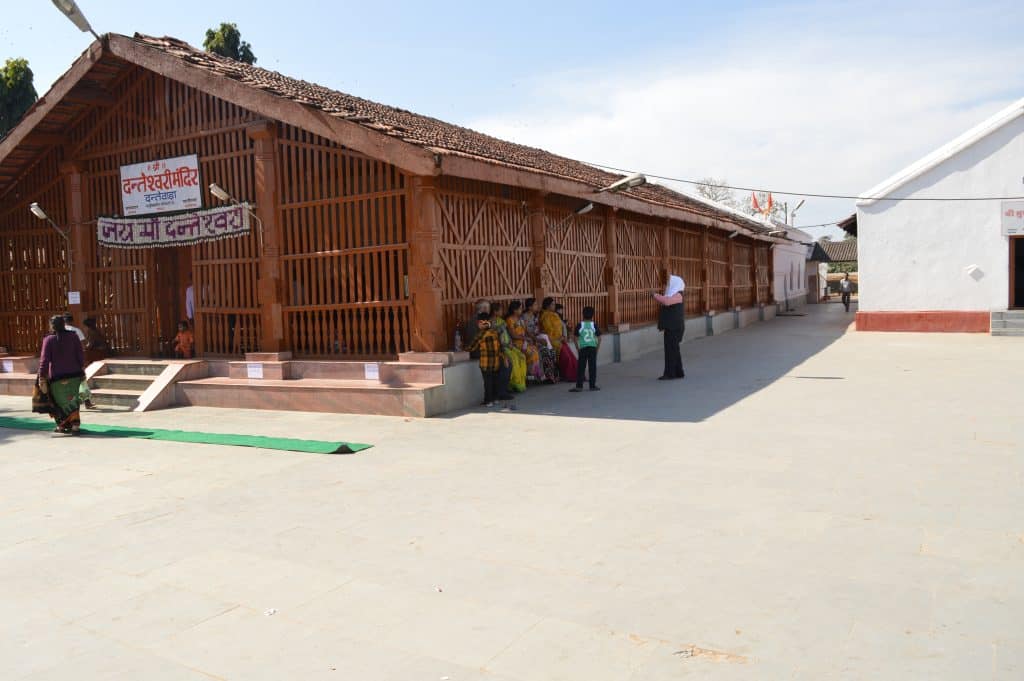I am eager to illustrate the divine supreme power of this universe, the spiritual ‘Shakti'(power), Goddess Durga. Being an ardent devotee of the Goddess Durga, my pen finds words every moment to sketch her heavenly deeds. From that point of view, I am writing down a few words about Danteshwari Temple, which is dedicated to Goddess Danteshwari, an incarnation of Shakti, Goddess Durga. According to the Hindu Scriptures, this temple, ‘Devi Purana,’ is considered one of the fifty-two Shakti Peethas(seats of the female force) across the Indian subcontinent. This temple locates its abode in the Dantewada district, about eighty km away to the south-west of Jagdalpur Tehsil, Chhattisgarh, at the confluence of the holy rivers, Shankini and Dhankini near the Bastar palace. The word ‘Dantewada’ is derived from the name ‘Goddess Danteshwari’, the presiding deity of the earlier ‘Kakatiya'(1163-1323 CE) rulers. She is the family goddess and tutelary of Bastar state(a princely state in India founded in the early 14th century, i.e. 1324 CE by Annamaraja).
Historical records that enriched this temple
Although this temple is less known to much of Indians, it conveys the testimonies of six hundred years of historical records, which bring the heritage to its devotees cum tourists. The Chalukya Kings of this region established this temple during the 14th century, i.e. in 1324 CE. Annamaraja, the brother of the last Kakatiya King Prataprudra II, made his nephew the next king of Baster state and went on to the dense forest, ‘Dandakaranya’ with the family goddess and installed the goddess in a temple at Dantewada. A large number of devotees of the goddess followed him to the forest. The Kings of Bastar took the responsibilities of hereditary high priests of the Danteshwari temple, which brought them a lot of honour among the tribal community. Apart from that, the Danteshwari temple and the beginning of the Maoist insurrection in Bastar are inseparably attached.
The legend that familiarised this temple as Shakti Peetha
Despite being uninvited, Devi Sati attended Her father’s(King Daksha) auspicious and princely yajna(sacrificial religious ritual) came to be known as ‘Brihaspatistava Yajna’ in the ‘Satya Yuga'(the first era of fours) in which She and Her beloved husband lord of the universe, Lord Shiva were humiliated nastily. Initially, Devi Sati tried her best to digest all this, but when She failed to intake all this nonsense, She committed self-immolation in the fire pit of yajna kund. The onlookers tried their best to rescue Her alive, but it was so late, and they were only able to take out the unburnt corpse of Hers. Her consort Lord Shiva became, raged with this mishap and demolished the yajna of King Daksha and decapitated him. Not only that, He, with the corpse of Devi Sati, started to do ‘Tandava'(rampage) to destroy the universe. Lord Vishnu then cut the dead body of the Goddess Sati with his ‘Sudarshan Chakra'(disc of auspicious vision) to appease Lord Shiva arose from the death of His wife. Sudarshan Chakra cut the dead body of Goddess Sati into fifty-two parts, and her ornaments fell on the Indian sub-continent, which became holy Shakti Peethas gradually. Among these pieces, it is believed that a tooth of Hers had fallen here, and Danteshwari Shakti Peetha came into being.
Architectural attractions: This temple was built similarly to the typical South Indian style of architecture. The image of Goddess Danteshwari is carved in black stone. The temple comprises Garbha Griha, Maha Mandap, Main Mandap and Sabha Mandap. Garbha Griha and Maha Mandap were constructed with the same stone pieces. The temple’s posture is in the middle of a grand, decorated, spacious courtyard with beautiful pillars and massive walls. A ‘Garuda Pillar'(was called the Garuda standard by Heliodorus, an ambassador of the Indo-Greek king Antialcidas from Taxila, referring to the deity Garuda) is at the entrance of the temple. The Shikhara(the superstructure tower or spire above the sanctuary and the pillared mandapas) is ornamented with sculptural grandeur.
Festivals that are celebrated in this temple: Danteshwari Temple is famous for its celebrations of ‘Dussehra’ and ‘Navaratri’, which are marked with pompous every year between September to October. During the festival of ‘Dussehra’ thousands of tribals from adjoining villages and jungles gather here to pay their homages to the goddess Danteshwari when her idol is taken out of that ancient temple, then starts an elaborate procession. And now, it has become the ‘Bastar Dussehra’ festival which goes on for seventy-five days, attracting visitors. Besides this, the festivity of ‘Navaratri’ is also famous for its ‘Jyoti Kalasha'(a symbolic representation of Hindu goddess Durga, consists of earthen lamps lit with ghee, placed on earthen pots, i.e. on Kalasha, covered with an earthen lid. The fire burns continuously for nine days and nights in Navaratri).
Temple opening time and visiting time:
Temple opening time: 5:00 a.m. to 7:00 p.m.
Temple aarti time: 5:30 a.m. shift and 6:30 p.m. shift.
Visiting time: 5:30 a.m. to 6:45 p.m.
Dress code: Males are allowed inside the main temple only in dhotis, whereas females can get entrances only in suits or sharees. But devotees and tourists must remember they are not permitted in jeans and trousers inside the sanctum sanctorum.
How to reach: Jagdalpur is well connected by road with its nearby cities. Raipur(116 km), Rajnandgaon(133 km) and Jabalpur(220 km) bus stations are the nearest bus stations.
The nearest railway station is the Jagdalpur Railway Station which takes around half an hour to reach the temple. Raipur Railway Station is also the nearest railway station, 36 km from the temple.
Mana Airport(Raipur Airport) is the nearest airport, which is 130 km away from the temple. Vishakhapatnam airport is the next closest airport which is 400 km away from the temple.
Image courtesy: Ratnesh1948
